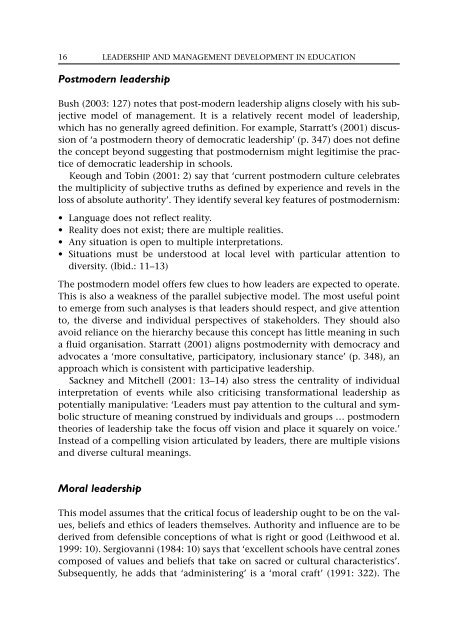Leadership and Management Development in Education (Education ...
Leadership and Management Development in Education (Education ...
Leadership and Management Development in Education (Education ...
Create successful ePaper yourself
Turn your PDF publications into a flip-book with our unique Google optimized e-Paper software.
16LEADERSHIP AND MANAGEMENT DEVELOPMENT IN EDUCATIONPostmodern leadershipBush (2003: 127) notes that post-modern leadership aligns closely with his subjectivemodel of management. It is a relatively recent model of leadership,which has no generally agreed def<strong>in</strong>ition. For example, Starratt’s (2001) discussionof ‘a postmodern theory of democratic leadership’ (p. 347) does not def<strong>in</strong>ethe concept beyond suggest<strong>in</strong>g that postmodernism might legitimise the practiceof democratic leadership <strong>in</strong> schools.Keough <strong>and</strong> Tob<strong>in</strong> (2001: 2) say that ‘current postmodern culture celebratesthe multiplicity of subjective truths as def<strong>in</strong>ed by experience <strong>and</strong> revels <strong>in</strong> theloss of absolute authority’. They identify several key features of postmodernism:• Language does not reflect reality.• Reality does not exist; there are multiple realities.• Any situation is open to multiple <strong>in</strong>terpretations.• Situations must be understood at local level with particular attention todiversity. (Ibid.: 11–13)The postmodern model offers few clues to how leaders are expected to operate.This is also a weakness of the parallel subjective model. The most useful po<strong>in</strong>tto emerge from such analyses is that leaders should respect, <strong>and</strong> give attentionto, the diverse <strong>and</strong> <strong>in</strong>dividual perspectives of stakeholders. They should alsoavoid reliance on the hierarchy because this concept has little mean<strong>in</strong>g <strong>in</strong> sucha fluid organisation. Starratt (2001) aligns postmodernity with democracy <strong>and</strong>advocates a ‘more consultative, participatory, <strong>in</strong>clusionary stance’ (p. 348), anapproach which is consistent with participative leadership.Sackney <strong>and</strong> Mitchell (2001: 13–14) also stress the centrality of <strong>in</strong>dividual<strong>in</strong>terpretation of events while also criticis<strong>in</strong>g transformational leadership aspotentially manipulative: ‘Leaders must pay attention to the cultural <strong>and</strong> symbolicstructure of mean<strong>in</strong>g construed by <strong>in</strong>dividuals <strong>and</strong> groups … postmoderntheories of leadership take the focus off vision <strong>and</strong> place it squarely on voice.’Instead of a compell<strong>in</strong>g vision articulated by leaders, there are multiple visions<strong>and</strong> diverse cultural mean<strong>in</strong>gs.Moral leadershipThis model assumes that the critical focus of leadership ought to be on the values,beliefs <strong>and</strong> ethics of leaders themselves. Authority <strong>and</strong> <strong>in</strong>fluence are to bederived from defensible conceptions of what is right or good (Leithwood et al.1999: 10). Sergiovanni (1984: 10) says that ‘excellent schools have central zonescomposed of values <strong>and</strong> beliefs that take on sacred or cultural characteristics’.Subsequently, he adds that ‘adm<strong>in</strong>ister<strong>in</strong>g’ is a ‘moral craft’ (1991: 322). The
















